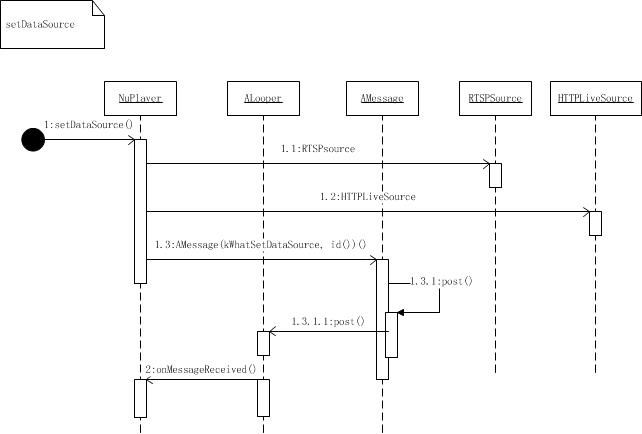AHandler机制
AHandler机制
Android APP开发中为了不阻塞UI线程,利用handler,把UI线程分开异步执行,使用handler去执行某项比较费时的操作,然后异步更新UI线程。这部分是用Java来实现的,和传统Java的线程机制很类似。
流媒体(5.0中用的是NuPlayer)中也是类似的,因为联网,codec都很费时,需要异步执行。AHandler机制基于C++的实现,NuPlayer就是继承了AHandler,实际上就是用的AHandler。
对于handler消息机制,构成就必须包括一个Loop,message。那么对应的AHandler,也应该有对应的ALooper, AMessage。底层的多媒体框架NuPlayer中,都是用AHandler消息机制实现的。
结合Nuplayer的构造和媒体播放实现流程中的setDataSource来说明。
####1. NuPlayer构造
首先从NuplayerDriver的构造函数,这是流媒体(NuPlayer)播放初始化函数。代码位置:
frameworks/av/media/libmediaplayerservice/MediaPlayerFactory.cpp
class NuPlayerFactory : public MediaPlayerFactory::IFactory {
public:
…
virtual sp<MediaPlayerBase> createPlayer() {
ALOGV(" create NuPlayer");
return new NuPlayerDriver;
}
};
// NuPlayerDriver中初始化的关键项
NuPlayerDriver::NuPlayerDriver()
: mState(STATE_IDLE),
mIsAsyncPrepare(false),
mAsyncResult(UNKNOWN_ERROR),
mSetSurfaceInProgress(false),
mDurationUs(-1),
mPositionUs(-1),
mSeekInProgress(false),
mLooper(new ALooper), // 创建一个 ALooper
mPlayerFlags(0),
mAtEOS(false),
mLooping(false),
mAutoLoop(false),
mStartupSeekTimeUs(-1) {
ALOGV("NuPlayerDriver(%p)", this);
mLooper->setName("NuPlayerDriver Looper"); // 给该Looper取名字,以便与AHandler一一对应
mLooper->start( // 启动Looper
false, /* runOnCallingThread */
true, /* canCallJava */
PRIORITY_AUDIO);
mPlayer = new NuPlayer; // 创建一个AHandler即Nuplayer
mLooper->registerHandler(mPlayer); // 把该AHandler注册到Looper中,具体的实现我们往后看
mPlayer->setDriver(this);
}
// 看到Looper就看成thread,ALooper的启动函数
status_t ALooper::start(
bool runOnCallingThread, bool canCallJava, int32_t priority) {
if (runOnCallingThread) {
…
}
Mutex::Autolock autoLock(mLock);
if (mThread != NULL || mRunningLocally) {
return INVALID_OPERATION;
}
mThread = new LooperThread(this, canCallJava); // 创建一个新的thread
status_t err = mThread->run(
mName.empty() ? "ALooper" : mName.c_str(), priority); // Thread运行
if (err != OK) {
mThread.clear();
}
return err;
}
// 注册handler
ALooper::handler_id ALooper::registerHandler(const sp<AHandler> &handler) {
return gLooperRoster.registerHandler(this, handler);
}
ALooper::handler_id ALooperRoster::registerHandler(
const sp<ALooper> looper, const sp<AHandler> &handler) {
Mutex::Autolock autoLock(mLock);
if (handler->id() != 0) {
CHECK(!"A handler must only be registered once.");
return INVALID_OPERATION;
}
HandlerInfo info;
info.mLooper = looper; // NuPlayerDriver Looper
info.mHandler = handler; // NuPlayer
ALooper::handler_id handlerID = mNextHandlerID++;
mHandlers.add(handlerID, info); // 放进vector里
handler->setID(handlerID); // 设置handlerID,以便发送message时找到对应的handler
return handlerID;
}
ALooperRoster::ALooperRoster()
: mNextHandlerID(1), // 从一开始
mNextReplyID(1) {
}gLooperRoster是一个全局变量,并且是一个vector,以handler Id对应HandlerInfo,而HandlerInfo中包含的是一对Looper(就是thread)和handler。这样处理消息的时候,就以handler Id很快地找到对应的处理。
// Nuplayer本身也是个AHandler,因为其继承自AHandler。
struct NuPlayer : public AHandler {
NuPlayer();
…
}
struct AHandler : public RefBase {
AHandler()
: mID(0) {
}
ALooper::handler_id id() const {
return mID;
}
sp<ALooper> looper();
protected:
virtual void onMessageReceived(const sp<AMessage> &msg) = 0; // 处理消息
private:
friend struct ALooperRoster;有了LOOPER,也有了对应的handler,以setdataSource方法为例,很清晰地看到送消息给LOOPER,交个相应的handler去处理。
2. 以setDataSource看AHandler处理消息机制
void NuPlayer::setDataSourceAsync(
const sp<IMediaHTTPService> &httpService,
const char *url,
const KeyedVector<String8, String8> *headers) {
sp<AMessage> msg = new AMessage(kWhatSetDataSource, id()); // 创建消息
size_t len = strlen(url);
sp<AMessage> notify = new AMessage(kWhatSourceNotify, id()); // 创建消息
sp<Source> source;
if (IsHTTPLiveURL(url)) {
source = new HTTPLiveSource(notify, httpService, url, headers);
} else if (!strncasecmp(url, "rtsp://", 7)) {
source = new RTSPSource(
notify, httpService, url, headers, mUIDValid, mUID);
} else if ((!strncasecmp(url, "http://", 7)
|| !strncasecmp(url, "https://", 8))
&& ((len >= 4 && !strcasecmp(".sdp", &url[len - 4]))
|| strstr(url, ".sdp?"))) {
source = new RTSPSource(
notify, httpService, url, headers, mUIDValid, mUID, true);
} else {
sp<GenericSource> genericSource =
new GenericSource(notify, mUIDValid, mUID);
// Don't set FLAG_SECURE on mSourceFlags here for widevine.
// The correct flags will be updated in Source::kWhatFlagsChanged
// handler when GenericSource is prepared.
status_t err = genericSource->setDataSource(httpService, url, headers);
if (err == OK) {
source = genericSource;
} else {
ALOGE("Failed to set data source!");
}
}
msg->setObject("source", source);
msg->post();
}NuPlayer中的setDataSource主要做了这些事情:
1 创建相应的消息
2 根据URL创建对应的source
3 onmessageReceive处理对应的消息
首先新建一个AMessage的实例,传入的参数为事件的名称以及处理该消息的Handlerid,该id在mLooper->registerHandler(mPlayer);方法中设置上。
AMessage::AMessage(uint32_t what, ALooper::handler_id target)
: mWhat(what),
mTarget(target),
mNumItems(0) {
}
void AMessage::setObject(const char *name, const sp<RefBase> &obj) {
setObjectInternal(name, obj, kTypeObject);
}
void AMessage::setObjectInternal(
const char *name, const sp<RefBase> &obj, Type type) {
Item *item = allocateItem(name);
item->mType = type;
if (obj != NULL) { obj->incStrong(this); }
item->u.refValue = obj.get();
}
// post过程
void AMessage::post(int64_t delayUs) {
gLooperRoster.postMessage(this, delayUs);
}
status_t ALooperRoster::postMessage(
const sp<AMessage> &msg, int64_t delayUs) {
sp<ALooper> looper = findLooper(msg->target()); // target及为获取handler id
if (looper == NULL) {
return -ENOENT;
}
looper->post(msg, delayUs);
return OK;
}
void ALooper::post(const sp<AMessage> &msg, int64_t delayUs) {
Mutex::Autolock autoLock(mLock);
int64_t whenUs;
if (delayUs > 0) {
whenUs = GetNowUs() + delayUs;
} else {
whenUs = GetNowUs();
}
List<Event>::iterator it = mEventQueue.begin();
while (it != mEventQueue.end() && (*it).mWhenUs <= whenUs) {
++it;
}
Event event;
event.mWhenUs = whenUs;
event.mMessage = msg;
if (it == mEventQueue.begin()) {
mQueueChangedCondition.signal();
}
mEventQueue.insert(it, event); // 插入到event queue里
}
// 当队列里有消息时便会触发loop函数:
bool ALooper::loop() {
Event event;
{
Mutex::Autolock autoLock(mLock);
if (mThread == NULL && !mRunningLocally) {
return false;
}
if (mEventQueue.empty()) {
mQueueChangedCondition.wait(mLock);
return true;
}
int64_t whenUs = (*mEventQueue.begin()).mWhenUs;
int64_t nowUs = GetNowUs();
if (whenUs > nowUs) {
int64_t delayUs = whenUs - nowUs;
mQueueChangedCondition.waitRelative(mLock, delayUs * 1000ll);
return true;
}
event = *mEventQueue.begin();
mEventQueue.erase(mEventQueue.begin());
}
gLooperRoster.deliverMessage(event.mMessage); // 处理消息
// NOTE: It's important to note that at this point our "ALooper" object
// may no longer exist (its final reference may have gone away while
// delivering the message). We have made sure, however, that loop()
// won't be called again.
return true;
}
void ALooperRoster::deliverMessage(const sp<AMessage> &msg) {
sp<AHandler> handler;
{
Mutex::Autolock autoLock(mLock);
ssize_t index = mHandlers.indexOfKey(msg->target());
if (index < 0) {
ALOGW("failed to deliver message. Target handler not registered.");
return;
}
const HandlerInfo &info = mHandlers.valueAt(index);
handler = info.mHandler.promote();
if (handler == NULL) {
ALOGW("failed to deliver message. "
"Target handler %d registered, but object gone.",
msg->target());
mHandlers.removeItemsAt(index);
return;
}
}
handler->onMessageReceived(msg); // 这里就回去调用NuPlayer
}
void NuPlayer::onMessageReceived(const sp<AMessage> &msg) {
switch (msg->what()) {
case kWhatSetDataSource:
{
ALOGV("kWhatSetDataSource");
CHECK(mSource == NULL);
status_t err = OK;
sp<RefBase> obj;
CHECK(msg->findObject("source", &obj));
if (obj != NULL) {
mSource = static_cast<Source *>(obj.get());
} else {
err = UNKNOWN_ERROR;
}
CHECK(mDriver != NULL);
sp<NuPlayerDriver> driver = mDriver.promote();
if (driver != NULL) {
driver->notifySetDataSourceCompleted(err);
}
break;
}
}
}Ahandler就是实现了异步机制,大致就是启动一个threadLooper,监听looper的消息队列是否有变化,如有交给相应的Handler去处理。
NuPlayer底层播放器所有 的实现依赖于这样的AHandler机制转动起来的。Android底层有很多类似的AHandler应用的地方,如在render中、获取m3u8 playlist的地方….
